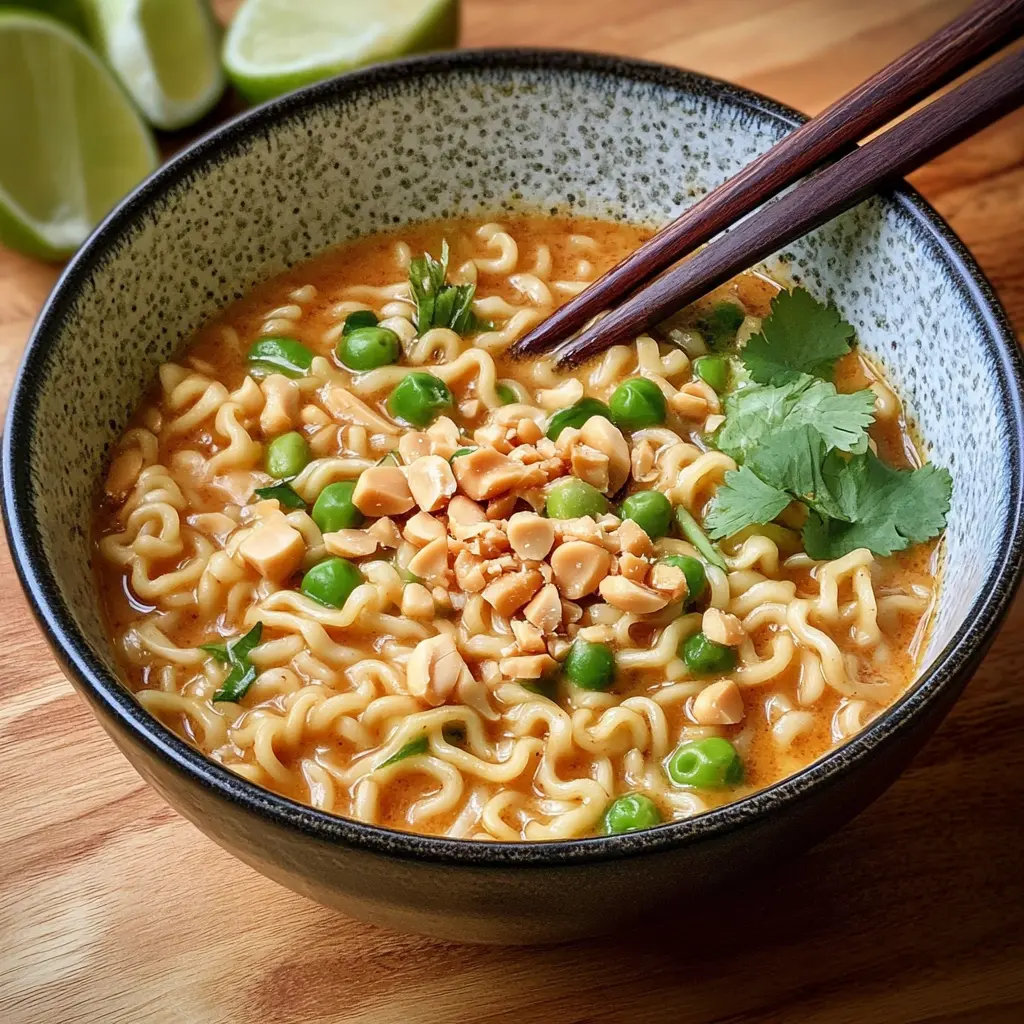This Creamy Spicy Thai Peanut Ramen Delight recipe transforms humble ramen noodles into a flavorful and satisfying meal that’s quick, easy, and bursting with Thai-inspired flavors. It’s a perfect balance of creamy peanut butter, savory soy sauce, sweet honey, and a fiery kick of sriracha, all coating perfectly cooked ramen noodles. Garnished with fresh green onions, crunchy peanuts, and a squeeze of lime, this dish is a delightful explosion of textures and tastes in every bite.
Why You Will Love This Recipe
This ramen recipe is a weeknight winner for so many reasons. First and foremost, it’s incredibly fast to make. From start to finish, you can have a steaming bowl of this deliciousness in under 20 minutes. Secondly, it requires minimal ingredients, most of which you probably already have in your pantry. Peanut butter, soy sauce, honey, and sriracha are pantry staples for many, making this a convenient option when you’re short on time or inspiration. The recipe is also highly customizable. You can easily adjust the level of spiciness by adding more or less sriracha, or tailor the sweetness by tweaking the amount of honey. It’s a great way to experiment with flavors and create a dish that perfectly suits your palate. Finally, it’s a comforting and satisfying meal that appeals to a wide range of tastes. Whether you’re a student on a budget, a busy professional, or simply craving something delicious and easy, this Creamy Spicy Thai Peanut Ramen Delight is sure to hit the spot. The combination of creamy, savory, sweet, and spicy is simply irresistible!
Ingredients:
- 2 packs ramen noodles
- 3 tablespoons peanut butter
- 2 tablespoons soy sauce
- 1 tablespoon honey
- 1 teaspoon sriracha (adjust to taste)
- 1 teaspoon sesame oil
- ½ cup reserved pasta water (as needed)
- 2 green onions, sliced (for garnish)
- ¼ cup chopped peanuts (for garnish)
- 1 lime, cut into wedges (for garnish)
Preparation:
Step 1: Bring a large pot of water to a boil over high heat. This ensures the ramen noodles cook evenly and quickly. Use enough water to fully submerge the noodles, preventing them from sticking together. A generous amount of water also helps to dilute the starch released by the noodles, resulting in a less sticky final product.
Step 2: Add the ramen noodles to the boiling water and cook to desired doneness, about 3 to 5 minutes. Follow the package instructions for the specific cooking time, as it may vary depending on the brand and type of ramen noodles you’re using. Cook the noodles al dente, meaning they should be firm to the bite, rather than mushy. Overcooked ramen noodles can become sticky and lose their appealing texture.
Step 3: While the ramen noodles are cooking, prepare the peanut sauce. In a large bowl, whisk together the peanut butter, soy sauce, honey, sriracha, and sesame oil until smooth. Use a whisk to ensure the ingredients are thoroughly combined, creating a homogenous sauce. If the peanut butter is particularly thick, you may need to add a tablespoon or two of hot water to help it blend more easily. Taste the sauce and adjust the seasonings to your liking. Add more sriracha for extra heat, or more honey for a sweeter flavor.
Step 4: Before draining the ramen, reserve ½ cup of the pasta water. This starchy water is a key ingredient in creating the creamy texture of the sauce. The starch in the water helps to bind the sauce to the noodles, creating a luscious and flavorful coating. If you forget to reserve the pasta water, you can use regular water, but the sauce may not be as creamy or thick.
Step 5: Drain the noodles well and immediately toss them with the peanut sauce until well-coated. Ensure that the noodles are thoroughly drained to prevent the sauce from becoming diluted. Toss the noodles with the sauce while they are still hot, as this will help the sauce to adhere to the noodles more effectively. Use tongs or a large spoon to gently toss the noodles, ensuring that they are evenly coated with the peanut sauce.
Step 6: If the sauce is too thick, add the reserved pasta water, 1 tablespoon at a time, to thin it out until it reaches your desired consistency. The amount of pasta water needed will depend on the thickness of the peanut butter and the consistency you prefer for the sauce. Add the water gradually, mixing well after each addition, to avoid making the sauce too thin. The goal is to create a sauce that is creamy and coats the noodles without being overly thick or gloppy.
Step 7: Divide the ramen into bowls and garnish with sliced green onions, chopped peanuts, and lime wedges. The green onions add a fresh, vibrant flavor and a pop of color to the dish. The chopped peanuts provide a satisfying crunch and enhance the nutty flavor of the peanut sauce. The lime wedges add a zesty brightness that cuts through the richness of the sauce and balances the flavors.
Step 8: Serve immediately and enjoy! Ramen is best enjoyed hot, so serve the dish as soon as it’s prepared. Encourage diners to squeeze the lime wedges over their ramen before eating, and to mix the garnishes into the noodles for the best flavor and texture experience.
Cooking Rating:
- Ease of Preparation: Easy
- Time Commitment: Quick
- Kid-Friendly: Yes, adjust sriracha to taste
- Overall Deliciousness: Highly Delicious!
Serving Suggestions:
This Creamy Spicy Thai Peanut Ramen Delight is delicious on its own as a quick and satisfying meal. However, you can also enhance it with various additions. Consider adding grilled chicken, shrimp, or tofu for extra protein. Steamed vegetables like broccoli, carrots, or snap peas can add a healthy dose of nutrients and textural contrast. For an extra layer of flavor, try adding a fried egg on top. A sprinkle of sesame seeds or a drizzle of chili oil can also elevate the dish. This ramen is also great served with a side of edamame or a small salad.
Tips:
- Peanut Butter Choice: Creamy peanut butter works best for this recipe, as it creates a smoother sauce. However, you can use crunchy peanut butter if you prefer the added texture.
- Noodle Variations: While this recipe calls for ramen noodles, you can experiment with other types of noodles, such as udon or soba. Just adjust the cooking time accordingly.
- Spice Level: Adjust the amount of sriracha to your liking. If you’re sensitive to spice, start with a smaller amount and add more as needed.
- Make it Vegan: This recipe can easily be made vegan by using vegan-friendly ramen noodles and ensuring that the honey is replaced with agave or maple syrup.
- Meal Prep: The peanut sauce can be made ahead of time and stored in the refrigerator for up to 3 days. When ready to eat, simply cook the ramen noodles and toss them with the sauce.
Prep Time: 5 minutes
Cook Time: 10 minutes
Total Time: 15 minutes
Nutritional Information:
(Note: Nutritional information is an estimate and may vary based on specific ingredients and portion sizes.)
- Calories: Approximately 550-650 per serving
- Protein: 20-25 grams
- Sodium: 1200-1500 mg
Conclusion:
This Creamy Spicy Thai Peanut Ramen Delight is a testament to how simple ingredients can come together to create an incredibly flavorful and satisfying meal. It’s a perfect dish for busy weeknights, lazy weekends, or any time you’re craving a comforting and delicious bowl of noodles. With its customizable flavors and quick preparation, this recipe is sure to become a staple in your kitchen. So go ahead, give it a try, and experience the delightful combination of creamy, spicy, savory, and sweet in every bite!
Questions and Answers about this Recipe:
Q1: Can I use a different type of nut butter instead of peanut butter?
A: Absolutely! While peanut butter is the traditional choice for this recipe, you can definitely experiment with other nut butters like almond butter, cashew butter, or even sunflower seed butter (for a nut-free option). Keep in mind that each nut butter will impart a slightly different flavor to the sauce, so adjust the other seasonings accordingly to achieve your desired taste. For example, almond butter has a milder flavor than peanut butter, so you might want to add a pinch more salt or soy sauce to compensate.
Q2: How can I make this recipe gluten-free?
A: To make this recipe gluten-free, the most important substitution is to use gluten-free ramen noodles. There are several brands of gluten-free ramen available in most grocery stores or online. Additionally, double-check the soy sauce you’re using, as some brands contain wheat. Tamari is a great gluten-free alternative to soy sauce. With these two simple swaps, you can enjoy this delicious ramen dish without any gluten!
Q3: Can I add vegetables to this ramen dish? If so, what kind would you recommend?
A: Yes, adding vegetables to this ramen dish is a fantastic way to boost its nutritional value and add some extra texture and flavor! Some great options include steamed broccoli florets, shredded carrots, sliced bell peppers, snap peas, spinach, or even sautéed mushrooms. For vegetables that require longer cooking times, like carrots or broccoli, it’s best to steam or sauté them beforehand and then add them to the ramen in the final step. Leafy greens like spinach can be added directly to the hot noodles and sauce, as they will wilt quickly.
Q4: How long does the leftover ramen last in the refrigerator?
A: While this ramen is best enjoyed fresh, leftovers can be stored in an airtight container in the refrigerator for up to 2 days. Keep in mind that the noodles may absorb some of the sauce over time, becoming a bit softer. To reheat, simply microwave the ramen for a minute or two, or heat it in a saucepan over low heat, adding a splash of water or broth if needed to loosen the sauce.
Q5: I don’t have sriracha on hand. What can I use as a substitute?
A: If you don’t have sriracha, you can use other chili sauces or pastes as a substitute. Gochujang (Korean chili paste) would add a similar level of heat and a slightly different flavor profile. Chili garlic sauce is another great option, providing both heat and garlic flavor. Alternatively, you can use a pinch of red pepper flakes or a dash of your favorite hot sauce to add some spice to the dish. Just adjust the amount to your liking based on your preferred level of spiciness.




